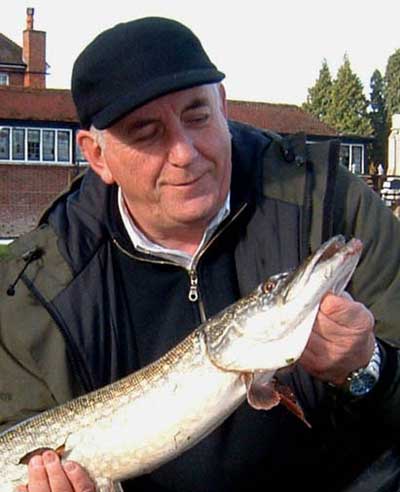  Jeff with a lure-caught pike |
Fooling Fish with Artificials
THERE AREN’T THAT many articles on FM about pike fishing and I can’t remember when the last one was about spinning and general lure fishing for pike and perch. So I thought it was time that we had a couple of articles to first of all encourage more of you to have a go and secondly to explain some basics for those who want to try it. I’ll tell you this, you may not catch the biggest pike ever, but you will enjoy it for there is no finer feeling than fooling a fish with an artificial lure.
Rods
If you don’t have a spinning rod then look at the rods you have already got. Is there an Avon rod or stronger, perhaps a barbel rod? They’re probably around the 11 or 12 feet mark, which for me is a bit long, but for the sake of trying it out, they’ll be good enough. Chris Leibrandt once told me that he often went lure fishing with his John Wilson Avon Quiver rod, with the Avon top attached.
However, if you do wish to purchase a rod specifically for lure fishing then anything between 6 and 9 feet would be perfect, I prefer the shorter rods of 6½ or 7 feet always. If they have casting weights on them, look for one casting anything between 10 grams and 30 grams for light fishing or 20 to 50 grams for slightly heavier fishing. This is for pike fishing, of course, for perch spinning you might want one even lighter casting from 3 grams to 15 grams.
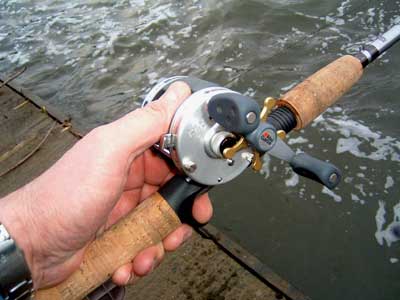  Short lure fishing rod and this how you hold it |
There are also two types of rod, the standard spinning rod much like all other rods with a straight handle, but shorter. Then there’s the ‘casting’ rod with trigger grip, which is meant to be used upside-down with casting reels or multipliers. Look at the picture of the multiplier, you can see how the forefinger fixes around the trigger handle to make casting easier with the multiplier types of reel.
Lines
For lines, use a standard nylon on a fixed spool reel or braid on a multiplier. Line strengths 10lb minimum for the nylon and perhaps even 30lb and more for the braid (these are for pike) since this will have about the same diameter as a 10lb line or less. The braid just allows a more direct connection with the lure since there is no stretch in the line. Some braids such as Fireline and Power Pro can be used on fixed spool reels, but a lot of softer braids tend to build up line twist and this can cause horrendous problems after a lot of casts.
Other Important Tackle
You should always carry with you a pair of long, very strong forceps. I cut the front inch off mine so they create an even stronger grip at the tip and you don’t need fine pointy forceps with pike hooks. A good short pair are also worth having or, you could always take a pair of long nosed pliers. Since there will be times when you have to cut through traces, hooks and swivels, buy yourself a good pair of side cutters with long handles such as the Fox ones pictured, you will find these invaluable too!
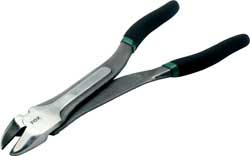  Side Cutters |
Not entirely necessary, but useful is a filleting glove, typically the one by Normark. These will not stop a pike’s tooth going through and into your finger (and that will happen at some stage), but what they will do is give you more confidence in holding the pike under it’s gill rakers (under the jaw). Gill rakers can be sharp along the edge and can cause small cuts (a bit like paper cuts) if the pike is frisky and wearing a glove just prevents you getting any infections from the water like Weil’s disease.
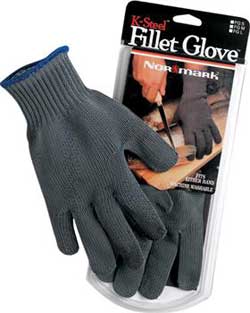  Normark Filleting Glove |
Traces are also important, as ever, when pike fishing. From 25lbs and more for pike (I even use 10 or 15lb Drennan Soft Strand wires for perch just in case a small jack grabs the bait). Make them at least 15-18 inches long with strong swivels and snap links. If you can’t make them, buy them ready made, but buy top quality and strong ones as losing a fish with a lure fastened to its mouth is NOT good angling practice!
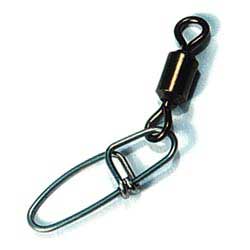  Fox Safe-Lok Link Swivels or Berkley Cross-Lok swivels |
If you do make them yourself, use swivels that are up to the job, 40 or 50lbs test swivels. Also the snap links, look out for the Fox Safe-Lok Link Swivels or Berkley Cross-Lok, they’re both about the same in design and strength and these are the best, I’ve found. Watch out for wear on them and use them for no more than two or three sessions before replacing them depending how many fish you catch or snags you have to pull from.
Tip: When you do replace the link, cut it away from the swivel it comes on with the side cutters and use the swivel again at the top of the next trace. Swivels will last a long time, but the opening and closing of the links puts extra stress on them. It’s not worth losing a fish for the cost (31p or so) of a new link.
The Lures
Basically, they break down into four groups. Spoons sweep from side to side, up and down as they’re retrieved and look like a dying fish. Spinners and spinnerbaits (the difference will be explained) obviously involve parts that spin to create vibration and movement in the water. Then there’s what we used to collectively call ‘plugs’, these include crankbaits, surface baits, and now there’s jerkbaits to add to that group. Last is the very latest in fashion, the rubber collection, lures that look and feel like fish – or not, depending on which rubber baits you buy.
Each has its own style of retrieval and this is often explained on the packet or leaflet enclosed with the bait. You can spend a small fortune on baits, but remember – providing you don’t lose them, they will last a long time unless they catch that many pike they start to look really tatty and need replacing. It’s amazing though how many lures can be ‘past their best’ and yet because of the action designed into them, they will continue to catch fish.
As for the cost, anything from a £ 2 spoon to a £ 15 jerkbait sounds a lot especially when you lose one, but if you’re careful this can be avoided. Even so, compare that with coarse fishing generally where a matchman will spend £ 15 – £ 30 on one match or a pleasure angler will happily throw in £ 6 worth of groundbait and loose offerings. A £ 6.50 lure could last for many trips over many years, some of mine are up to 35 years old and still attracting pike.
Be careful though, as an old tackle shop friend of mine once reminded me, most lures are meant to catch anglers first, fish after! Buy lures that you know will work and if you buy anything else, understand that it’s an ‘experimental’ one. I have lots of experimental ones! Choose a good range of colours because when you’re fishing, you’ll probably want bright colours for bright days and duller colours for duller days. That’s not a golden rule because like all fishing, the only golden rule is that there are NO golden rules.
Before we go any further, I would like to thank Barrie Rickards (who writes a monthly piece for FM), who is not only a top pike angler but founding President of the Lure Fishing Society of Great Britain. He did a very interesting video ‘Success with the Lure’ some years ago (you might still find it for sale and if so, it is worth it) in which he recommends a few lures and since trying them myself about ten years ago, I have to agree they are crackers! So apologies for duplicating him by recommending some of them again here. Proves he’s right though!
Spoons
Perhaps my most favourite of lures. They cast well, they’re relatively cheap, you get them in a wide range of lengths, widths and weights, and the colour range is now unbelievable. You fish them either on a straight retrieve, sink and draw where you lift the lure and let it flutter down, or jerked along by twitching the rod tip to mimic a wounded or dying fish.
Tip: If on the straight retrieve they appear to spin too much, attach a swivel immediately onto the lure’s split ring to reduce line twist. All spoons should have a 8-10mm split ring on the front, never attach the link directly to the spoon as this puts more stress on the link clip!
Another method that Barrie recommends in his video is to play it around directly in front of you, especially when you have deep water straight in front. You can lift it to one side, let it flutter down, lift it again to the other side and so on. You bet, if there’s a pike anywhere around you’ll draw him out with this method.
They all sink, so like all baits that sink always get to know how fast it sinks before casting it. Count it down in a safe area where you aren’t going to get snagged up. Usually you can reckon on one foot per second, but really heavy spoons can go down like bricks. Then there are some large light spoons called flutterers, that may sink slightly slower. Being lighter though, this could mean they won’t cast quite so far, so as you can guess, there is a payoff.
One of the best spoons is one of those recommended by Barrie, it is the Lucky Strike Lizard. It just seems to combine all the best features in the one design, which is fairly unique in its shape. Barrie suggested the hammered nickel/copper finish (used to suffer from rust, but the last one I bought has had no such problem) and although I have tried other colours over the years, this remains one of my favourites also. The hammered nickel/red and the all gold are also good alternatives.
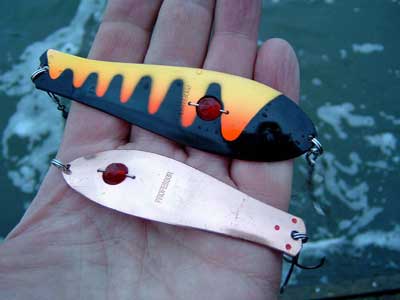  Kuusamo Professor |
The Kuusamo Professor is a classic that’s been around for many years, I first read about it and acquired one back in the 70s. Now available in a wide range of new colours and even bigger sizes means it’s better than it’s ever been. You can put the hook on either end for a slightly different action. Whether you choose the new giant 180mm (7 inches) or the original 90mm model this is a lure that will not let you down.
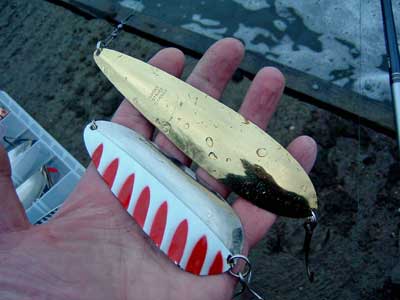  Half Wave and Canoe |
These are the two I would heartily recommend. I have others, some may be either discontinued or they are now only available in the USA, where this sport is most popular. One is the Lucky Strike Canoe, which won me a pike match one year. We were allowed to spin providing we didn’t move from the peg so I decided to give it 15 minutes or so at the beginning. It landed me a 91/2 -pounder and that turned out to be the heaviest caught. It also accounted for the one shown in the introduction shot that Christian took.
Others I have and like are the Toothy Critter Mister Muskie (now discontinued, but you can see the size in the picture, my hand being 4inches across) and another Lucky Strike lure, the Half Wave, only available in Canada and the USA, it seems. Although the Abu Toby appears to be very popular I have never taken a pike on one. I may be very unusual, very unlucky or just a rubbish lure angler, but I have tried lots of them and to me they just don’t have the action I am looking for. Be careful also about buying some cheap ones off eBay, some may be good like two that I bought, but many do seem to be rubbish. Look for brand names you know and remember ‘caveat emptor’, let the buyer beware.
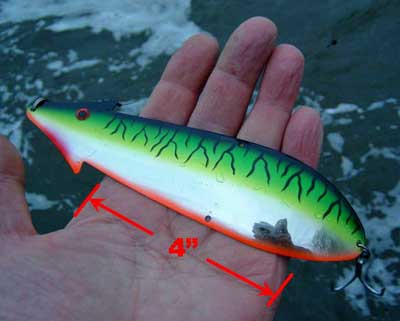  Mister Muskie |
It is worth keeping your eye on eBay though for any of those Toothy Critter lures as they do appear from time to time. I’ve even spoken to Masterline who supplied them and they have no intention of reintroducing them. Amen!
Adaptations you can make
There’s not much you can do to improve a well designed spoon, it will behave as the designer intended and will therefore catch you fish.
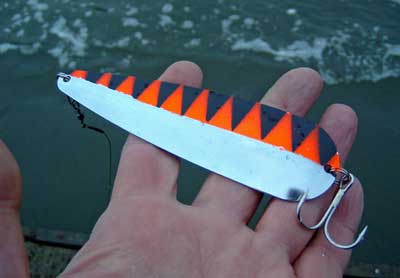  Here’s one I sprayed earlier |
However, you can change the colour if you lose confidence in the one you bought. The tiger tooth (my name for it) in fluorescent orange and black is easily created by putting masking tape halfway across the spoon lengthways. You then spray the unmasked half with a white matt base before spraying it with the orange. All paints are Plasti-Koat from DIY stores.
You then need to take a piece of thick paper or thin card and cut several deep Vs into it at the same depth. When the first coats are dry, hold this jagged edge over the orange you sprayed and cover with the black. You don’t need to coat it with resin or anything else since if it gets so bad through wear and tear, you can always re-spray it again.
That’s it for the first part of this short series. Next we’ll look at the other baits and how to fish some of these lures (providing the river drops in time before the end of the season).










